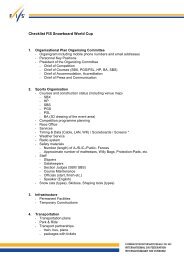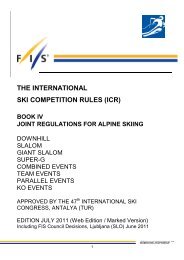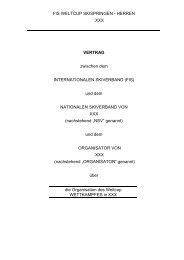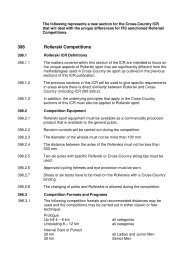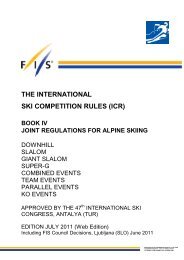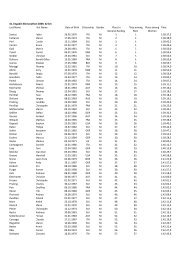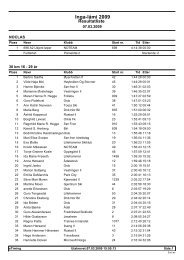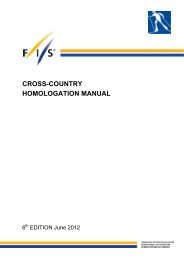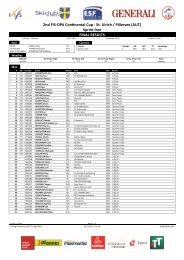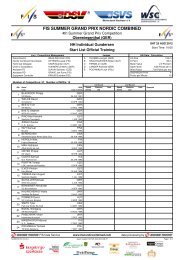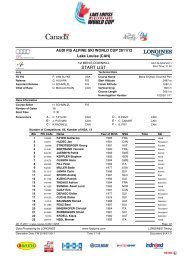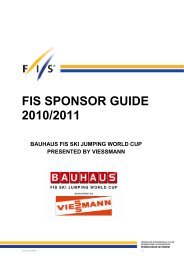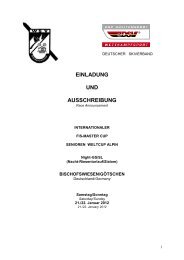THE INTERNATIONAL SKI COMPETITION RULES (ICR) BOOK II - Fis
THE INTERNATIONAL SKI COMPETITION RULES (ICR) BOOK II - Fis
THE INTERNATIONAL SKI COMPETITION RULES (ICR) BOOK II - Fis
You also want an ePaper? Increase the reach of your titles
YUMPU automatically turns print PDFs into web optimized ePapers that Google loves.
315.7 False Start Consequences<br />
315.7.1 For competitions using interval start or handicap start procedures a competitor<br />
who makes a false start will not be recalled to the start line. False<br />
start infractions must be reported to the Jury.<br />
315.7.2 For all competitions using a mass start or heat start procedure, any false<br />
start will result in a “restart” of the competition. The starter is required to<br />
give a restart signal (second shot) and must have assistants placed an effective<br />
distance down the tracks where it is possible to turn the competitors<br />
back.<br />
315.8 Marking of Skis<br />
315.8.1 Ski marking will not be used unless requested in advance by the sanctioning<br />
body of the competition. For purposes of control, both skis are marked<br />
shortly before the start. The competitor must come to the official marking<br />
place in person and in due time wearing his starting bib.<br />
315.9 Temperature<br />
316 Timing<br />
If the temperature is below -20° C, measured at the coldest point of the<br />
course, a competition will be postponed or cancelled by the Jury. With difficult<br />
weather conditions (e.g., strong wind, high air humidity, heavy snowfall,<br />
or high temperature) the Jury may, in consultation with the Team Captains<br />
of the participating teams and the Chief of medical and rescue service<br />
responsible for the competition, postpone or cancel the competition.<br />
316.1 For all competitions listed in the FIS Calendar, electronic timekeeping<br />
must be used. Electronic timing will always be supplemented by handtiming<br />
as a backup system and the results cross-checked between the two<br />
systems.<br />
316.2 If the electronic timing temporarily fails hand times will be used by correcting<br />
the average time difference which develops between the electronic<br />
timing and the hand-timing. If the electronic timing fails frequently or completely<br />
during the competition, the hand times will be used for all the competitors.<br />
When hand times are used to calculate results, the actual start<br />
times must be used.<br />
316.3 When using hand-timing, the time is taken when the competitor's first foot<br />
crosses the finish line.<br />
316.4 Electronic Timing<br />
316.4.1 The following electronic timing technologies can be used to identify the<br />
official finish times:<br />
- Electronic timing system based on photo cells. The measuring point of<br />
the light or photo barrier must be at a height of 25 cm above the snow<br />
surface<br />
- Electronic timing system based on transponders<br />
- Photo finish system. The measuring point will be the toe of the first<br />
boot meeting the finish line.<br />
50



